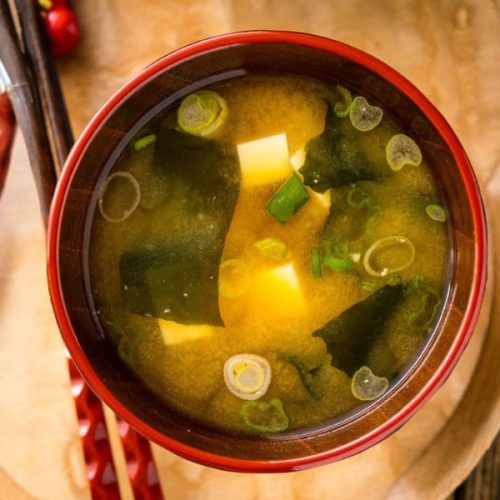
20-Minute Miso Soup
This light, savory Japanese miso soup features a homemade dashi base, soft silken tofu, wakame seaweed, and fresh green onions. Nutrient-rich, plant-based, and ready in just 20 minutes.
Equipment
- 1 Medium saucepan
- 1 Fine-mesh strainer
- 1 Miso ladle or small bowl
- 1 Sharp chef’s knife
- 1 cutting board
Ingredients
- For the Dashi makes ~4 cups
- 4 cups water
- 1 piece kombu dried kelp, 10 g / 4 x 4 inches
- 1 cup katsuobushi dried bonito flakes, loosely packed
- For the Miso Soup
- 7 oz soft/silken tofu kinugoshi dofu, cubed
- 4 Tbsp miso paste adjust to taste
- 1 Tbsp dried wakame seaweed
- 1 green onion/scallion thinly sliced
Instructions
- Prepare the Kombu Dashi: Begin by placing 4 cups of cold water and a 10-gram piece of kombu (dried kelp) in a medium saucepan. If time allows, soak the kombu for 30 minutes to help release its natural umami. Slowly heat the water over medium-low heat, ensuring it never boils, so the delicate flavors infuse gradually. Just before it reaches a boil, carefully remove the kombu and set it aside to avoid bitterness, leaving behind a clear, mineral-rich Kombu Dashi.
- Enhance with Katsuobushi (Optional): For non-vegetarian dashi, add 1 cup of loosely packed katsuobushi (dried bonito flakes) to the Kombu Dashi and bring the mixture gently to a boil. Reduce heat immediately and let it simmer for 30 seconds to extract a smoky, savory flavor. Turn off the heat and allow the flakes to settle to the bottom for about 10 minutes. Strain the dashi through a fine-mesh sieve to achieve a clear, amber-colored broth known as Awase Dashi.
- Dissolve the Miso Paste: Return the strained dashi to the saucepan and gently warm it over medium heat until it reaches around 205°F (96°C), making sure it does not boil. Place 4 tablespoons of miso paste in a small bowl or ladle, then gradually add a small amount of warm dashi while stirring with chopsticks or a miso muddler until smooth. Slowly incorporate the dissolved miso back into the main pot, ensuring an even distribution without clumps. Adjust the seasoning with additional miso or dashi if desired.
- Add Tofu and Wakame: Cut 7 ounces of silken tofu into ½-inch cubes using a sharp knife on a cutting board to maintain shape. Gently fold the tofu into the miso soup, taking care not to break the delicate cubes. Sprinkle in 1 tablespoon of dried wakame seaweed and allow it to rehydrate briefly in the warm soup. Add thinly sliced green onions right before serving to preserve their bright color, fresh aroma, and crisp texture.
- Serve and Enjoy: Ladle the hot miso soup into individual bowls, ensuring each serving has tofu, wakame, and green onions. Serve immediately while warm to enjoy the full depth of umami flavors. For reheating leftovers, gently warm the soup without boiling to maintain the delicate miso aroma. Pair with steamed rice or a light salad for a complete, comforting Japanese meal.
Notes
- Always dissolve miso paste in warm dashi before adding it to the soup to prevent clumping.
- Avoid boiling the soup after adding miso to preserve delicate flavors and probiotics.
- Use silken or soft tofu for a smooth, creamy texture; firmer tofu can be used but may alter the mouthfeel.
- Rehydrate dried wakame separately if you prefer a less salty soup.
- Kombu and katsuobushi can be reused in other Japanese dishes, such as simmered vegetables or rice stock, to reduce waste.
- Adjust miso paste quantity to taste; start with less and add gradually for perfect balance.